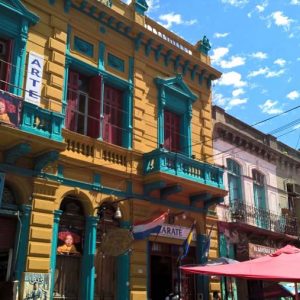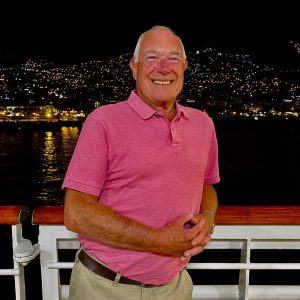Stay in touch with General Charles De Gaulle, the ultimate French patriot
Charles de Gaulle is probably the most widely known French personality of the 20th century. He died of natural causes at his home in the Champagne-Ardenne region as he approached his 80th birthday on 9 November 1970. His house and possessions are preserved for all to see.
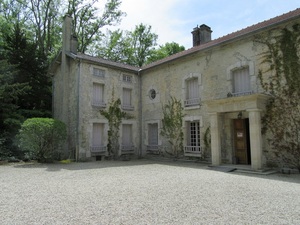 The background to his life is complex and daunting. It was his fervent patriotism inherited from his father that sustained him for all of his days. Charles de Gaulle was born in Lille, married in Calais and died in the village of Colombey-les-Deux-Eglises to the south east of Paris. Visitors are welcome in this peaceful French township to see for themselves the circumstances of his life. He and his wife Yvonne had three children. One was a girl who was named Ann. She had a severe life limiting mental impairment and died at the age of twenty.
The background to his life is complex and daunting. It was his fervent patriotism inherited from his father that sustained him for all of his days. Charles de Gaulle was born in Lille, married in Calais and died in the village of Colombey-les-Deux-Eglises to the south east of Paris. Visitors are welcome in this peaceful French township to see for themselves the circumstances of his life. He and his wife Yvonne had three children. One was a girl who was named Ann. She had a severe life limiting mental impairment and died at the age of twenty.
De Gaulle’s father was a mathematics and philosophy teacher. He was also a veteran of the Franco Prussian war. He always felt humiliated and desired revenge after the capture of the Alsace Lorraine region. He ensured that his son Charles was thoroughly educated in French history and indoctrinated him with a fierce national patronage. The history of the family dated right back to Agincourt. Nationalism and patriotism were ingrained in the ancestral genes.
Charles de Gaulle chose military service and joined the exclusive army academy of Saint-Cyr in 1909. He was a tall man with an imposing personality and was known by a nick name, ‘Big Asparagus’ by his compatriots. After he had graduated, he first reported to Marshall Petain who he greatly admired. Due to subsequent events, he later came to hate him.
Charles fought bravely in both World Wars gaining slow but steady promotion through the ranks up to the highest level. He was taken prisoner five times whilst he attempted five escapes. De Gaulle was badly injured in the French battle of Verdun during the Great War and was left for dead in a cart. He had lived though and was securely imprisoned by the Germans until the end of the war.
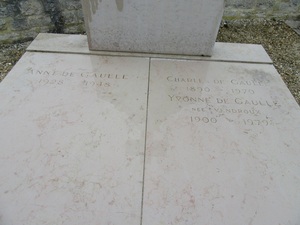 During the Second World War, Charles de Gaulle had come to despise Marshall Petain. Petain had capitulated parts of France to the German state in return for his co-operation. De Gaulle unswervingly maintained his desire for a free French nation. Fearing capture, he escaped to London and remained there as a guest of Winston Churchill until 1944. He operated as the leader of the Free French Army or Resistance from afar. He used the BBC to powerfully broadcast encouragement and leadership. He became famous for his proclamations around the world. He had adopted the French Cross of Lorraine as his symbol because of its historical associations.
During the Second World War, Charles de Gaulle had come to despise Marshall Petain. Petain had capitulated parts of France to the German state in return for his co-operation. De Gaulle unswervingly maintained his desire for a free French nation. Fearing capture, he escaped to London and remained there as a guest of Winston Churchill until 1944. He operated as the leader of the Free French Army or Resistance from afar. He used the BBC to powerfully broadcast encouragement and leadership. He became famous for his proclamations around the world. He had adopted the French Cross of Lorraine as his symbol because of its historical associations.
In 1934, Charles de Gaulle had bought a modest house using his moderate army salary. It was in the village of Colombey-les-Duex-Eglises in the Champagne Ardenne region of France. He returned to it after the Second World War had ended to live there with his wife and disabled daughter.
The house was originally called The Brasserie due to its association with brewing. Charles changed the name to La Boisserie, a title he apparently made up. It still exists and consists of twelve rooms including three living rooms and six bedrooms. After Charles de Gaulle had died, the house was purchased by a collection of his associates. Today it is kept perfectly preserved as a monument to Charles de Gaulle and as almost a shrine to French nationalism. It is an extraordinarily interesting place to visit if you happen to be passing.
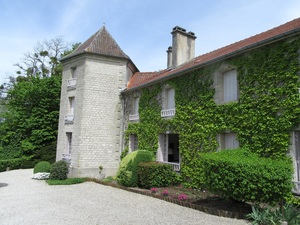 Around 50000 people explore the house each year. The grounds stretch over two and a half hectares. They are secluded, green, peaceful and elegant. De Gaulle and his family used their house for periods of seclusion during their lives. The term ‘Colombey’ became a political metaphor for a place of retreat until recalled by the French people for public service and leadership.
Around 50000 people explore the house each year. The grounds stretch over two and a half hectares. They are secluded, green, peaceful and elegant. De Gaulle and his family used their house for periods of seclusion during their lives. The term ‘Colombey’ became a political metaphor for a place of retreat until recalled by the French people for public service and leadership.
The house today remains exactly as he left it. The contents have little financial value but they are very much the artefacts of his distinguished life. The furniture, paintings and portraits on the walls and many scattered objects of the time constituted his private and family life. It is an impeccable example of classic Gallic taste and style. In his memoirs, Charles said ‘It is my home’. Visitors will sense an almost unique blend of permanence and security as they view the living spaces.
After the liberation of Paris in 1944, De Gaulle was elected Premier after the Germans were pushed out of Normandy. He resigned after a year or so due to his sharp objection to state governance by the political party system. He returned to Colombey with his family to write his memoirs. Charles de Gaulle had become a respected writer during his lifetime.
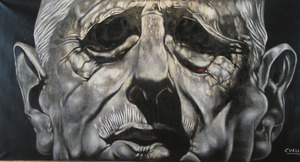 Charles de Gaulle was once again re-called by the people of France in 1958. There was a need for leadership at the highest level and he was elected President.
Charles de Gaulle was once again re-called by the people of France in 1958. There was a need for leadership at the highest level and he was elected President.
During the next few years he defied senior military figures and granted independence to the protected state of Algeria. This caused intense anger and hatred within some senior circles. A few high ranking military people formed a terrorist organisation called the OAS. They wanted to assassinate Charles de Gaulle as punishment for what they saw as abandonment. There were eight carefully planned attempts on his life by the secret OAS. They all failed due largely to circumstances of bad luck. Watch the excellent film ‘The day of the Jackal’ starring Edward Fox. It is a dramatic and accurate account of the final, failed attempt on De Gaulle’s life. The leaders of the attempt were caught, convicted and executed by the French state.
In 1969, Charles De Gaulle stepped down again as President this time. A national referendum had gone against him concerning reform of the Senate. It conflicted with his enduring sense of French nation and patriotism. He returned once more to his home at Colombey with his wife and daughter.
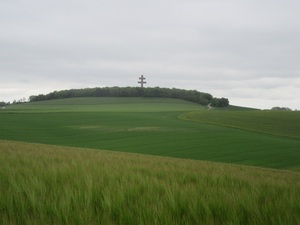 In 1972, after De Gaulle’s death, a hugely impressive statue of the Cross of Lorraine was erected on a hill top on the edge of the village of Colombey-les-Deux-Eglises. The Cross symbol and Charles de Gaulle were synonymous. The completion of the statue was marked by the attendance of Georges Pompidou, the French President at the time. The monument is 150 feet high and weighs 1500 tons. At the base, a plaque simply bears his name for perpetuity. It can be seen from miles around, identifying the village perched up high on the isolated hill top. It is a symbol for French freedom, French aspiration and the very tall Charles de Gaulle himself. The outstretched arms of the cross seem to embrace the complete nation.
In 1972, after De Gaulle’s death, a hugely impressive statue of the Cross of Lorraine was erected on a hill top on the edge of the village of Colombey-les-Deux-Eglises. The Cross symbol and Charles de Gaulle were synonymous. The completion of the statue was marked by the attendance of Georges Pompidou, the French President at the time. The monument is 150 feet high and weighs 1500 tons. At the base, a plaque simply bears his name for perpetuity. It can be seen from miles around, identifying the village perched up high on the isolated hill top. It is a symbol for French freedom, French aspiration and the very tall Charles de Gaulle himself. The outstretched arms of the cross seem to embrace the complete nation.
Visitors can climb up the hill and see it themselves. It is accompanied by a modern museum portraying French life over the last century. It also displays two of De Gaulle’s motor cars. They are both elderly Citroens, both French and still operate perfectly.
Charles de Gaulle, like Joan of Arc, was a supporting figure that all French people turned to in times of crisis. He displayed unwavering courage and patriotism during very difficult times. He was never intimidated by his attackers. He felt that destiny would always protect him.
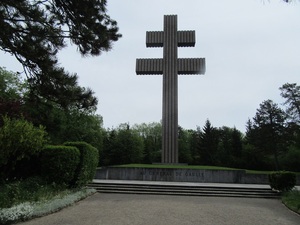 Charles died at La Boisserie in 1970. The desk where his death occurred remains for all to view. He was apparently writing his memoirs and got up to look through the window. He suffered a massive heart attack and fell dead. It is a curious position to gaze upon. He is buried with his wife Yvonne and daughter Anne in the Churchyard at Colombey-les-Deux-Eglises. His coffin lies next to his daughter and under that of his wife. His humble resting place was something that he had always requested.
Charles died at La Boisserie in 1970. The desk where his death occurred remains for all to view. He was apparently writing his memoirs and got up to look through the window. He suffered a massive heart attack and fell dead. It is a curious position to gaze upon. He is buried with his wife Yvonne and daughter Anne in the Churchyard at Colombey-les-Deux-Eglises. His coffin lies next to his daughter and under that of his wife. His humble resting place was something that he had always requested.
On the day of his funeral, a simultaneous state service was held in Notre Dame Cathedral in Paris. Senior politicians and statesmen from around the world were in attendance. The leading figure was not however. He was home once more being buried in his beloved village. Visit the humble rusting metal cross in the village churchyard that reminds visitors of his life. The family grave lies a few metres away.


